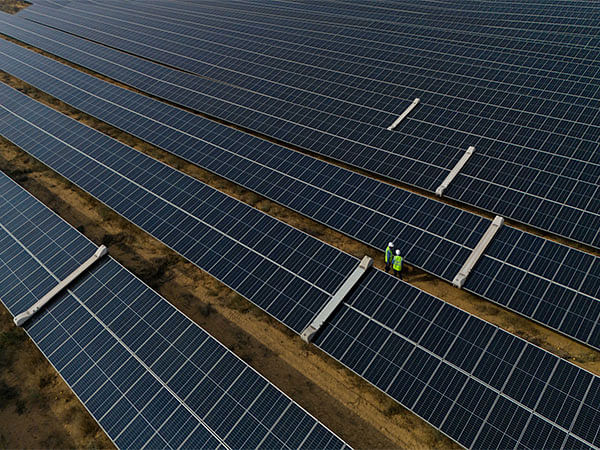New Delhi [India], May 24 (ANI): India, committed to climate mitigation programme, today stands 4th globally in renewable energy installed capacity, 4th in wind power capacity and 5th in solar power capacity, as per International Renewable Energy Agency – Renewable capacity statistics 2023.
The recent government initiatives have played a major role in this. As of November 2023, the Ministry of New and Renewable Energy has approved 50 solar parks with an aggregate capacity of around 37,490 MW in 12 states across the country.
Also, the domestic industry is looking for ways to push this aggressively.
At COP26 held in 2021, India committed to an ambitious five-part “Panchamrit” pledge. They included reaching 500 GW of non-fossil electricity capacity, generating half of all energy requirements from renewables, to reducing emissions by 1 billion tonnes by 2030.
India as a whole also aims to reduce the emissions intensity of GDP by 45 per cent. Finally, India commits to net-zero emissions by 2070.
About 44 per cent of India’s energy requirements at present come from non-fossil sources and are likely to touch as high as 65 per cent by 2030, much higher than what the country pledged at the COP summit in 2021.
India’s ambitious target of reaching 500 GW by 2030 and net zero by 2070 would require green transition in the way its people live and in the way they business.
The intent for a green change can be seen in the hiring for green jobs. Studies suggest that India has the potential to create 35 million green jobs by 2047.
New job positions are emerging in the green industry because of climate change. As the clean energy sector is expanding, so is the demand for renewable energy professionals.
In 2021-22, the renewable energy sector hiring was eight times that in 2020-21. The solar and wind energy sectors alone added close to 53,000 workers in project development roles in 2021-22, as per a report by CEEW-NRDC and the Skill Council for Green Jobs.
The IEA World Employment report 2023 noted a surge in clean energy jobs globally. In India, the solar and wind energy sectors are adding thousands of workers to new projects and will continue to create steady employment opportunities in the coming years.
With an estimated requirement of 220 GW of solar capacity by the end of this decade, India needs to significantly ramp up its manufacturing capacity. Its solar photovoltaic (PV) module manufacturing capacity exceeded 39 GW by September-end 2022 and is expected to reach about 95 GW by the end of 2025.
Adani Solar, the solar PV manufacturing arm of the Adani portfolio, aims to boost India’s position as the global solar manufacturing hub. It is building India’s first fully integrated and comprehensive solar manufacturing ecosystem of 10 GW in Mundra, Gujarat. It will be the group’s largest manufacturing set-up and is expected to create over 13,000 green jobs.
The project, which will be completed by 2027, currently employs around 2,500 people for operations and maintenance, erection and commissioning, and support functions.
Another major player, Tata Solar Power, manufactures solar cells and modules, rooftop solar panels and solar water pumps. The company provides solar power to 13 state utilities in India, and has shipped more than 3 GW of solar modules worldwide. Its portfolio boasts India’s largest rooftop solar project, vertical solar farm and floating solar power project.
The Tata company employs around 1,000 people and will continue to add more as the scope of work expands.
Kolkata-based Vikram Solar reached 2.5 GW capacity in 2022 and offers services in engineering, procurement and construction, as well as operations and maintenance.
Emmvee, which manufactures solar water heating systems and solar panels, reached a module manufacturing capacity of 3 GW by 2023-end and expects to expand capacity to 5 GW in 2024. The Bangalore-based company employs 650 workers in India and at its sales offices in Germany.
The current fiscal began on a positive note with solar energy constituting a significant 18.66 per cent of the overall installed power capacity, totalling 82.63 GW. Renewable energy contributes 32.69 per cent to the total installed power capacity, amounting to 144.75 GW. The Adani Group has an operational capacity of 10.93 GW and plans to add 6 GW in 2025 and 6-8 GW every year thereafter.
According to the Skill Council for Green Jobs report, major policy reforms and production-linked incentives (PLI) are set to boost local manufacturing of green products. India’s emphasis on the LiFE (Lifestyle for Environment) Mission which is focused on sustainable living; ‘Panchamrit’, the government’s five-step plan to achieve net-zero emissions; and India’s steering of global initiatives, such as the International Solar Alliance, are seen shaping the global direction on green growth.
As per the report, these trends have the potential to help India unlock USD 1 trillion in value by 2030 and USD 15 trillion by 2070. (ANI)
This report is auto-generated from ANI news service. ThePrint holds no responsibility for its content.



